
An enchilada is a corn tortilla rolled around a filling and covered with a chili pepper sauce. Enchiladas can be filled with a variety of ingredients, including various meats, cheese, beans, potatoes, vegetables or combinations. Originating in Mexico, enchiladas are a popular dish throughout Mexico and the American Southwest.

Salsa is the Spanish word for any sauce. Salsa in the United States typically refers to any one of several sauces typical of Mexican cuisine, also known as salsa fresca, hot salsa or salsa picante, particularly those used as dips. Salsa is often tomato-based, and includes ingredients such as onions, chilies, an acid and herbs. It is typically piquant, ranging from mild to extremely hot. Though many different sauce preparations are called salsa in Spanish, in English, it generally refers to raw or near-raw sauces used as dips.

A chipotle, or chilpotle, is a smoke-dried ripe chile pepper used for seasoning. It is a chile used primarily in Mexican and Mexican-inspired cuisines, such as Tex-Mex and Southwestern dishes. It comes in different forms, such as chipotles en adobo.

Chili powder is the dried, pulverized fruit of one or more varieties of chili pepper, sometimes with the addition of other spices. It is used as a spice to add pungency or piquancy and flavor to dishes. In American English, the name is usually spelled "chili". In British English the spelling "chilli" is used consistently.
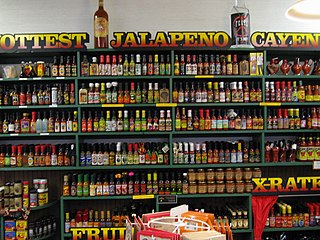
Hot sauce, also known as chili sauce or pepper sauce, is any condiment, seasoning, or salsa made from chili peppers and other ingredients.

The chile relleno is a dish in Mexican cuisine that originated in the city of Puebla.

Psychedelic Sexfunk Live from Heaven is a video album filmed in concert at Long Beach Arena, California on December 30, 1989 and released in 1990 on VHS. The video contains live, rehearsal and backstage footage of the Red Hot Chili Peppers with the lineup of Anthony Kiedis, Flea, Chad Smith, and John Frusciante during the Mother's Milk tour. The video has never been released on DVD and has long been out of print.

The poblano is a mild chili pepper originating in the state of Puebla, Mexico. Dried, it is called ancho or chile ancho, from the Spanish word ancho ("wide"). Stuffed fresh and roasted it is popular in chiles rellenos poblanos.
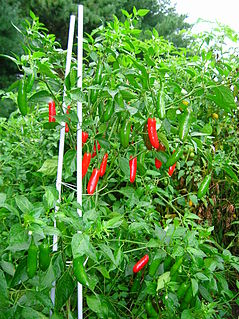
The serrano pepper is a type of chili pepper that originated in the mountainous regions of the Mexican states of Puebla and Hidalgo. The name of the pepper is a reference to the mountains (sierras) of these regions.

A guajillo chili or guajillo chile is the dried form of mirasol chili, a landrace variety of chile pepper of the species Capsicum annuum, and is the second-most commonly used dried chili in Mexican cuisine. after poblanos (ancho). The Mexican state of Zacatecas is one of the main producers of guajillo chilies. The two varieties are distinguished by their size and heat factors. The guajillo puya is the smaller and hotter of the two. In contrast, the longer and wider guajillo has a more pronounced, richer flavor and is somewhat less spicy.
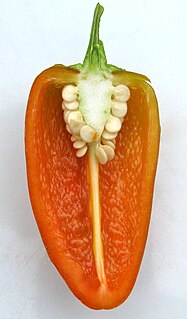
The Fresno Chili pepper is a medium-sized cultivar of Capsicum annuum. It should not be confused with the Fresno Bell pepper. It is often confused with the jalapeño pepper but has thinner walls, often has milder heat, and takes less time to mature. It is however a New Mexico chile, which is genetically distinct from the jalapeño and it grows point up, rather than point down as with the jalapeño. The fruit starts out bright green changing to orange and red as fully matured. A mature Fresno pepper will be conical in shape, 2 inches long, and about 1 inch in diameter at the stem. The plants do well in warm to hot temperatures and dry climates with long sunny summer days and cool nights. They are very cold-sensitive and disease resistant, reaching a height of 24 to 30 inches.

The Chile de árbol is a small and potent Mexican chili pepper also known as bird's beak chile and rat's tail chile. These chilis are about 5 to 7.5 cm long, and 0.65 to 1 cm in diameter. Their heat index is between 15,000 - 30,000 Scoville units. The peppers start out green and turn a bright red color as they mature. Chile de árbol peppers can be found fresh, dried, or powdered. As dried chiles, they are often used to decorate wreaths because they do not lose their red color after dehydration.
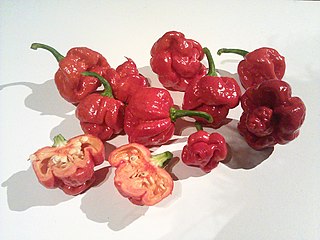
The Trinidad Moruga scorpion is a chili pepper native to the district of Moruga in Trinidad and Tobago. It currently is ranked as the second-spiciest chili in the world. On February 13, 2012, New Mexico State University's Chile Pepper Institute identified the Trinidad Moruga scorpion as the hottest chili in the world, with a mean heat of more than 1.2 million Scoville heat units (SHUs) and individual plants with a heat of more than 2 million SHUs. According to the Chile Pepper Institute, the previous record holder was the Bhut jolokia of India, as it never accepted the Infinity chili and Naga Viper pepper that were previous record holders per Guinness World Records. The current official world record holder is the Carolina reaper with 1.64 million SHU.

Oaxacan cuisine is a regional cuisine of Mexico, centered on the city of Oaxaca, the capital of the state of the same name located in southern Mexico. Oaxaca is one of Mexico's major gastronomic, historical, and gastro-historical centers whose cuisine is known internationally. Like the rest of Mexican cuisine, Oaxacan food is based on staples such as corn, beans and chile peppers, but there is a great variety of other ingredients and food preparations due to the influence of the state's varied geography and indigenous cultures. Corn and many beans were first cultivated in Oaxaca. Well known features of the cuisine include ingredients such as chocolate, Oaxaca cheese, mezcal and grasshoppers (chapulines) with dishes such as tlayudas, Oaxacan style tamales and seven notable varieties of mole sauce. The cuisine has been praised and promoted by food experts such as Diana Kennedy and Rick Bayless and is part of the state's appeal for tourists.

Dabu-dabu is a type of hot and spicy condiment commonly found in Manado cuisine of North Sulawesi, Indonesia. Dabu-dabu chopped red chili peppers, bird's eye chili, shallots, red and green tomatoes, and a pinch of salt and sugar. All of the chopped and diced spices are mixed with fresh calamansi juice or locally known as lemon cui or jeruk kesturi; sometimes calamansi is replaced by kaffir lime or lemon juice. The chili pepper and citrus juice give it a fresh sour and spicy flavour.

The Bhut jolokia, also known as ghost chili pepper, ghost chili and ghost jolokia, is an interspecific hybrid chili pepper cultivated in the Northeast Indian states of Arunachal Pradesh, Assam, Nagaland and Manipur. It is a hybrid of Capsicum chinense and Capsicum frutescens and is closely related to the Naga Morich of Nagaland and Bangladesh.
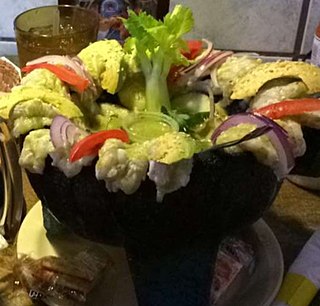
Aguachile is a Mexican dish made of shrimp, submerged in liquid seasoned with chili peppers, lime juice, salt, cilantro, slices of cucumber and slices of onion. Raw vegetables such as cucumber are usually added. This raw seafood dish comes from the Northwest region of Mexico and is normally prepared in a molcajete. The origin of aguachile lies in the coast of Sinaloa, originally made with boiled water and chiltepines, small round chili peppers from Sinaloa.

Bird's eye chili, bird eye chili, bird's chili, piri piri or Thai chili is a chili pepper, a variety from the species Capsicum annuum, commonly found in Ethiopia and across Southeast Asia. It is often confused with a similar-looking chili derived from the species Capsicum frutescens, the cultivar "siling labuyo". Capsicum frutescens fruits are generally smaller and characteristically point to the sky. It is used extensively in Thai, Malaysian, Singaporean, Lao, Khmer, Indonesian, and Vietnamese cuisines.

The habanero is a hot variety of chili pepper. Unripe habaneros are green, and they color as they mature. The most common color variants are orange and red, but the fruit may also be white, brown, yellow, green, or purple. Typically, a ripe habanero is 2–6 cm (0.8–2.4 in) long. Habanero chilis are very hot, rated 100,000–350,000 on the Scoville scale. The habanero's heat, flavor and floral aroma make it a popular ingredient in hot sauces and other spicy foods.































